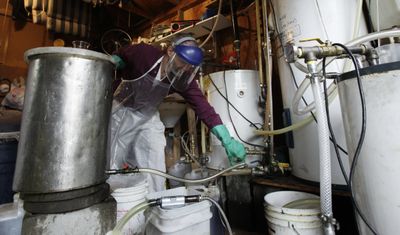Dangers accompany home biodiesel production
Amateur refiners risk fires, explosions

EDMONDS, Wash. – Trying to live green and beat high gasoline prices, some enterprising Americans are turning cooking oil into biodiesel in their garages. Problem is, some of these do-it-yourselfers are burning down the house.
Fire officials around the country are warning of the dangers and considering new restrictions to make sure people don’t torch the whole neighborhood.
“You won’t find a rule anywhere that says you can’t cook biodiesel in your garage,” said Bob Benedetti, a flammable-liquids engineer for the National Fire Protection Association in Quincy, Mass.
Ferocious fires and explosions blamed on backyard refining operations have been reported in Washington state, Arizona, Colorado, Massachusetts and Oregon. No deaths or serious injuries have resulted, but some fire officials say it is only a matter of time.
In recent years, many Americans have discovered that diesel cars can run on fuel made primarily from vegetable oil, and about the only drawback is a french fry smell. Some motorists are going so far as to brew their own fuel from used frying oil obtained from restaurants, which are often glad to get rid of the gunk for little or no charge.
Biodiesel is typically made by combining the cooking oil with methanol, or wood alcohol, in a mixture heated to about 120 degrees. But methanol is highly flammable. And frying oil, as any cook knows, can catch fire if it gets too hot or comes into contact with a flame.
The results can be spectacular, particularly in cases where home refiners have stockpiled tanks and barrels of material.
When a barn caught fire in 2006 outside Canby, Ore., “it was a huge column of black smoke unlike anything I’d ever seen in a typical fire,” said Canby Fire Marshal Troy Buzalsky. “We had flames that scorched nearby 70-foot trees. It was so hot that it burned aluminum and sagged metal.”
The blaze was caused by an electrical short, and the flames eventually ignited a 275-gallon plastic container of fuel.
“I took a lot of safety measures. It was pretty mind-blowing when I did have a fire,” said Jeff Brandt, the barn’s owner. He said he had even visited his local firehouse to let fire officials know what he was doing. But the blaze hasn’t discouraged Brandt from continuing to make fuel.
Setting up a home biodiesel operation is relatively easy. With hundreds of how-to guides posted online and kits for sale, enthusiasts can get started with less than $500.
“It’s a fun little hobby, like making your own beer,” said Lyle Rudensey, who brews about 50 gallons per month in his Seattle garage to heat his home and run his car. “It’s really kind of neat to go into your garage and fill up.”
But in the classes he has taught for three years, Rudensey urges people to take precautions such as storing chemicals in metal cabinets and keeping fire extinguishers on hand.
In December, a biodiesel blaze broke out in a shed in Edmonds and quickly destroyed the house.
Edmonds Fire Chief Thomas Tomberg said he wants to see a code that tells home-brewers what they can and cannot do.